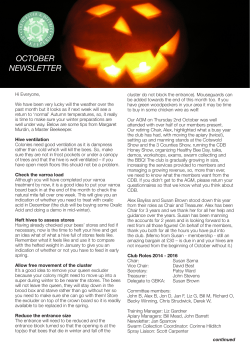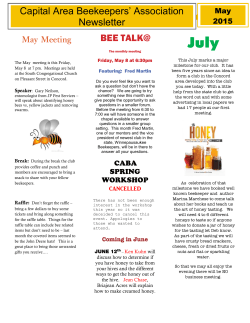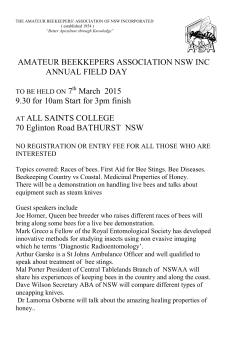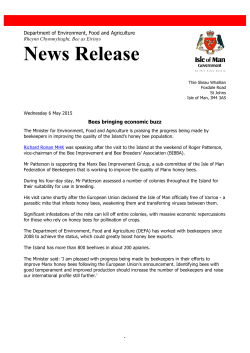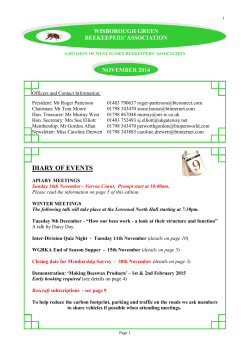
autumn 2015 beekeeper field day program & demonstration notes
AUTUMN 2015 BEEKEEPER FIELD DAY PROGRAM & DEMONSTRATION NOTES FEATURING PRACTICAL OPEN HIVE DEMONSTRATION HOW TO PREPARE YOUR HIVE FOR WINTER PROGRAM 9:45 Announcements & welcome 10:00 Practical Bee Demonstration 12:00 Lunch 1:00 Q & A 3:00 Close PRESENTED BY THE BENDIGO BRANCH OF THE VICTORIAN APIARISTS ASSOCIATION INC. President Don McArthur 54493294 Secretary Eileen McDonald 0439722128 SUNDAY 3rd MAY 2015 BENDIGO SCHOOLS TRADE TRAINING CENTRE AGRICULTURE AND HORTICULTURE ANNEX PLEASE NOTE: PRACTICAL BEE HANDLING DEMONSTRATIONS Participants are expected to provide their own personal protective equipment (PPE) AUTUMN BEEKEEPERS FIELD DAY PROGRAM & DEMONSTRATION NOTES BENDIGO BEEKEEPER GROUP Welcome to the 2015 Autumn Bendigo Beekeeper Field Day. This year we are trialing a new field day venue both as a response to an initiative to engage industry with trade training institutions and to provide enhanced learning opportunities for beekeepers. For the last few years our autumn pack down day as it was called has been conducted at the McDonald’s commercial apiary in Castlemain. We thank Eileen and Bob for making their facility available for these activities. The change to the new venue will obviate the need to restrict the numbers attending this field day. Beekeeping is currently enjoying some notoriety in recent times due to media attention to the worldwide decline of bees. In the UK steps are being made to encourage back yard beekeepers so that European bees as a species can be maintained. In the USA where colony collapse disorder is prevalent it is thought that several factors contribute to this condition. One of those factors is the unbalanced diet due to the prevalence of agricultural monocultures. The home gardens and allotment gardens have been shown to alleviate this problem. In Australia back yard beekeeping is undergoing some sort of revival and organizations such as ours are endeavoring to service the increased demand for information and support. Members of the Bendigo group can call upon more experienced beekeeper members for advice and assistance with any beekeeping issues ranging from building equipment, to recognizing bee colony aliments. A National program to address the management of beekeeping disease is currently being discussed by beekeepers and government representatives. Termed The Bio-security Code of Practice , it is written with all beekeepers in mind and aims to provide a disease management framework for beekeepers. Although many of the precepts are already covered by regulation and experienced beekeepers are often very familiar with the procedures, the code of practice formalizes it for everyone. The organizers are hopeful that the code can be implemented and well imbedded before we are challenged with an incursion of Varroa. The Honey industry is a leader in developing an industry led Bio-security program. Don McArthur. President AUTUMN BEEKEEPERS FIELD DAY PROGRAM & DEMONSTRATION NOTES FIELD DAY TIPS OPENING A BEE HIVE SMOKER: Smoke is what controls bees. Fuels – pine needles, gum leaves, stringy bark. Lighting – (in a cleared open space, or on the tail-gate of the ute) - a small loose ball of newspaper which is ignited first, then add a handful of fuel, avoid sticks as too much heat singes bees’ wings. Allow to ignite to flame then add more fuel and when thick white smoke ensues, close lid to stifle flames. You need to puff the bellows often to ensure your supply of smoke lasts out your inspection. Keep some spare fuel nearby so you can add a handful as needed. How to use Two to three firm puffs into the hive entrance, and the same as you open the lid. HIVE TOOLS – There are two types, Australian and American. Australian is the best type for the hobbyist beekeeper. - Hook under the top-bar lug to loosen the comb, - Blade is used to scrape burr comb off top bars and loosen tightly wedged combs. (Burr/brace comb is the excess wax that bees build for supporting combs, extra honey storage or drone comb). Opening the hive As you open the lid firmly puff some smoke under before you have it fully open (to send bees down into the hive). Place the lid – open side up – on the ground alongside the entrance within easy reach. Remove the top super (box) and place it on your upturned lid. The queen excluder will be secured with wax, so you will need to use the blade of your hive tool to loosen, stand it against the side of the hive towards the entrance. 2 AUTUMN BEEKEEPERS FIELD DAY PROGRAM & DEMONSTRATION NOTES Loosen, then take out second comb in the brood nest, You are not taking the wall comb first because there may be burr/brace comb built along the side of the box which will tear your comb and possibly kill bees as you lift it out. Layout of the brood nest in a strong hive is usually six (6) combs of brood and wall combs containing mostly honey and pollen. Check eggs, different ages of the larvae, drone brood. It is not necessary to find the queen to assess her condition. With pollen and nectar coming in freely, brood - from eggs, young larvae, to sealed and hatching brood will indicate her condition. To find the queen gently turn the cells towards the sun, scan the comb of brood, then turn over and scan the other side. Keep the bees as quiet as possible with an occasional gentle puff of smoke. Stored pollen and honey Check for fresh honey and pollen coming in. Check to make sure the bees have some stocks. FEEDING SUGAR SUPPLEMENT THREE METHODS 1. LIQUID SUGAR Containers that can be used: Aluminium foil trays (large range available) 10” x12” x2” are very good, holds approximately 2 litres; or polythene film available from Hardware stores (50x3 metre roll black plastic that Concreters use). Cut a piece 26’x40”, take out two frames from super. Put black plastic in as a bag, replace frames inside plastic. Holds approximately fourteen litres. Or use a top-hat feeder. ** Feeding sugar syrup in liquid form will stimulate bees to breed when bees are on good pollen and little or no nectar. ** In late winter/early spring, liquid sugar fed with pollen supplement will commence bees breeding earlier than normal 3 AUTUMN BEEKEEPERS FIELD DAY PROGRAM & DEMONSTRATION NOTES ** The heat produced by this supplement will help bees to breed during cold, wet weather. The mix consists of equal quantities by weight or volume, whatever suits the Operator. It is not necessary to be accurate with measurements, all that is needed is a thin syrup. For small quantities, hot water dissolves the granulated sugar more easily, but cold water works – it just takes longer. 2. WET GRANULATED SUGAR Place sugar in plastic bags, add water until sugar becomes wet. (Fruit/veg. bags from supermarket work well). Tie top of bag, place in hive close to bees. Put hole in top of bag. ** This is one way of feeding starving hives or hives that are short on stores. ** Using this method, sugar will not ferment (as can syrup, if kept). ** This method will also stimulate bees (though liquid is best). ** This method is suitable for hot, dry climates. ** Sometimes if not consumed quickly, this wet sugar will set in a cake and may need to be broken up/wet again a week later. 3. DRY SUGAR Place dry sugar on plastic or in trays close to the bees in the hive. ** This is one way of feeding starving hives, or hives that are light in humid or wet areas. SUMMARY The best method of feeding bees to stimulate them is with liquid sugar. Experience shows that the other two methods are survivable methods only to be used in desperation. Bob McDonald 4 AUTUMN BEEKEEPERS FIELD DAY PROGRAM & DEMONSTRATION NOTES OPEN HIVE DEMONSTRATION—NOTES PREPARING BEE COLONIES FOR WINTER Our bee colonies spend the summer diligently preparing for winter and we interfere with this by stealing some of their honey stores. The trick is to ensure that enough honey is left in the hive to sustain the colony for the duration of winter. Foraging at this time is limited due to either lack of flowering plants and even when there are flowing plants bees are required to remain in the hive to maintain a habitable brood temperature. The commercial beekeeper can solve both problems and shift his bees to warmer latitude where there may be flowering plants and warmer days. The hobby and part time beekeeper does not have the resources to relocate colonies and therefore must choose from the following options. Looking at the food stores problem first. 1. 2. Leave a sufficient quantity of honey in the hive to last all winter. a. As a rule of thumb 4 frames of brood and 4 frames of honey, making a single 8 frame box. This solution is problematic in several ways. At the end of the season there may be several half covered frames left. So in practice 8 frames are required necessitating an extra super. This option is not ideal due to the extra heat required to maintain the temperature in the larger hive. b. If the hives are robbed early in autumn the beekeeper must judge whether the bees can rebuild stocks to a sustainable level before the winter shuts the feeding activity down. If misjudged or a cold snap happens feeding will be required. c. Feeding the hive over the winter, apart from being an extra chore, is problematic in that; the hive may need to be opened at regular intervals releasing valuable heat and putting the brood at risk. d. If the stores are limited then the colony will be weak coming out of winter and consequently slow to build up in the spring and as a result miss out on early flowering crops. This may be critical if it is planned to use the colonies for pollination of almonds where the bee colonies are expected to be strong. Beekeepers who prepare for pollination by leaving extra honey in the hive in Autumn must factor in the lost honey in their profit and loss calculations. Setup the hive to make it easier for the bees to heat the hive. 5 AUTUMN BEEKEEPERS FIELD DAY PROGRAM & DEMONSTRATION NOTES a. As the heat is produced by the bee physical activity (i.e. Flapping their wings) food stores are consumed. Obviously the best option is to limit the number of times the hive is opened. Insulate the hive by placing insulation under the lid. Place two or more hives together so that they can share heat. b. Place the hives in a sunny disposition. In the past I have tried to address the problem of wintering bees using several methods. SINGLE BROOD BOX I have tried the single 8 frame box solution. The principal here is to pack a large quantity of bees into a small space and the extra bees can assist with temperature control. The problem is that the extra bees require extra food and the extra numbers, just as in any intensive livestock scenario requires extra vigilance. Higher stocking rates may leave the colony open to starvation and disease if the colonies are not vigilantly monitored. Where colonies need to be fed it may necessary to open the hive in cold weather further stressing the hive. DEEP BOTTOM BOARD In order to minimize heat loss in winter a beekeeper can use the European style deep bottom board system (See Fig 1.). Essentially the bottom board is constructed so that bees can be fed at the base of the colony and not at the top. Heat is not lost because the lid is not opened and feeding the colony is very simple as it can be done early in the day without smoke. The deep bottom board can also assist keeping hive litter away from the colony without exposing the colony to the bare ground as with other screened bottom board systems. INSULATED INNER LID An easy way to insulate the hive is to place a sheet of “coreflute” under the lid (see Fig. 2). Coreflute is the material real estate agents and political parties use for their advertising signs. In Europe beekeepers use a sheet of clear plastic film to seal off their colonies but the coreflute provides both the sealing and insulation properties. MULTIPLE HIVE ARRANGEMENTS In addition to the coreflute I place two hives side by side on a pallet for two purposes. One is to allow the sharing of heat source. In practice you notice that the bees establish brood frames adjacent to the side of the box that is next to the adjacent hive. The second purpose is the hives are more stable on the pallet and can be shifted with minimal disturbance. They can often be moved without the use of smoke and beekeeping clothing. The intent of the structural change in the hive arrangement is to be able to have strong colonies at the end of winter. The 6 AUTUMN BEEKEEPERS FIELD DAY PROGRAM & DEMONSTRATION NOTES disadvantage of this system is that when the hives are building up in spring they become too heavy to lift with a conventional hand truck. I will work on this problem in due course. PACK DOWN DAY JOBS CHECK THE BROOD If the new Bio-security program is adopted, beekeepers will be required to assess the health of their hives, at least twice a year. I currently do this at pack down and in the early spring as the colonies are developing. In the past I have justified not opening the brood box because the weather has been cold and the bees have built up a great deal of propolis, bonding the frames securely into the brood box making them very difficult to extract. A few years ago we were infected with American foul brood and had to destroy several hives. They say beekeepers that experience AFB become better beekeepers and in my experience the exercise teaches you to be much more conscientious. Where brood frames show the classic AFB symptoms of cell caps with holes, use a piece of stick to draw out the substance from inside the cell. If it stretches out to around 2 centimetres then you almost certainly have AFB. If it looks like AFB but does not stretch then you may have some other malady. If you are not sure you can either get a more experienced beekeeper to have a look or you or you can use one of the test kits that are available (See Fig. 3). Whatever the case, place the stick you used inside the hive and leave it there. Do not discard possible contaminated material on the ground. Where the hive has already collapsed, i.e. all the bees have died the test for ropey substance may not be available due to the substance drying out. In this case you may be able to observe the residue in the form of scale on/in the downside of the cells. Check for varroa mites by shaking several hundred bees into the sugar shake container (See Fig. 4) and dust onto a clean white sheet of paper (or water). TAKE NOTES Record what you have done in terms of the hives. How was the health of the hives? What is the brood situation? What steps did you take to remedy the situation? CLEAN UP My hives at the home apiary are very close to large red ant nests that were a problem when I first started. I have found that if I remove the leaf litter and sticks from around the front of the hives it either discourages ants or perhaps the bees are more able to encourage the ants to keep away. Whatever the case I take a leaf blower to my apiary at least twice a year. Don McArthur. 7 AUTUMN BEEKEEPERS FIELD DAY PROGRAM & DEMONSTRATION NOTES This page has been left blank for your note taking. 8 AUTUMN BEEKEEPERS FIELD DAY PROGRAM & DEMONSTRATION NOTES This page has been left blank for your note taking. 9 AUTUMN BEEKEEPERS FIELD DAY PROGRAM & DEMONSTRATION NOTES This page has been left blank for your note taking. 10 AUTUMN BEEKEEPERS FIELD DAY PROGRAM & DEMONSTRATION NOTES Fig. 1. Deep Bottom Board: 1. Hinged front and rear doors. 2. Hardware mesh prevents bees building burr comb. 3. Trash falls through mesh. 4. Feed tray inserted through back door. Fig. 2. Winter Cover. Coreflute inner lid. Note fluting sealed with duct tape. Fig. 3. AFB Test Kit. Instructions are on the back of packet. Bob’s Beekeeping Supplies We specialise in beekeeping protective clothing and equipment. Jackets, Overalls, Gloves, Extractors, Smokers. website : www.bobsbeekeeping.com.au Address: 79 Zig Zag Rd, Eltham, Victoria 3095 Fig. 4. Sugar Shake device. Ph. 0394395410 email: bob@bobsbeekeeping.com.au 11
© Copyright 2025

